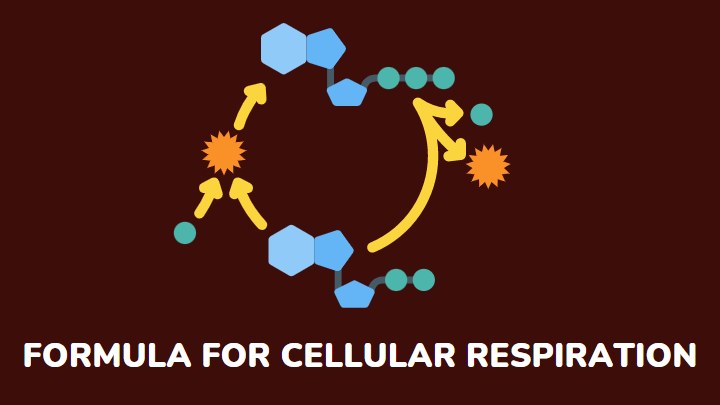What is the chemical formula for cellular respiration?
Cellular respiration is a chain of chemical reactions whereby living organisms use oxygen to break down organic molecules (food) to release energy in the form of adenosine triphosphate (ATP). This energy is in turn used to fuel various biological pathways.
Furthermore, food is absorbed into the body as glucose which is oxidized by oxygen molecules to yield carbon dioxide and water, with ATP alongside. Cellular respiration is simply a redox reaction.
These reactions that make up cellular respiration can also be written with their chemical formula. Let’s take a look at how this is done.
What is the chemical formula for cellular respiration?
C6H12O6 + 6O2 ———-> 6CO2 + 6H2O + ATP
In words,
Glucose + Oxygen ————> Carbon dioxide + Water + Energy
The above reaction is a sum of all that happens in glycolysis, the Krebs cycle, and electron transport. However, the processes have a more extensive pathway that uses compounds such as nicotinamide adenine dinucleotide (NAD+), pyruvates, acetyl coenzyme A, etc.
What are the stages of cellular respiration?
Glycolysis
The first stage of cellular respiration begins with the splitting of glucose. Three enzymes hexose, phosphofructokinase, and pyruvate kinase catalyze the series of reactions that break down glucose. The reaction is accompanied by a release of energy in the form of ATP.
C6H12O6 + 2NAD+ + 2ADP + 2Pi ———–> 2CH3(C=O)COOH (pyruvic acid) + 2ATP + 2NADH +2H+
Pyruvate decarboxylation
The final step of glycolysis is the decarboxylation of the pyruvate. In this step, the two pyruvates lose one carbon each in the form of carbon dioxide.
The acetyl fragments pick up metabolite coenzyme A to form acetyl CoA. NADH is also produced from NAD+ by the action of two high-energy electron pairs.
Afterward, the carbon dioxide is released, the acetyl CoA molecules enter the Krebs cycle, and the NADH carries high-energy electrons to the electron transport system.
Pyruvate + NAD+ + CoA → Acetyl-CoA + NADH + CO
Krebs cycle
The Krebs cycle or the tricarboxylic acid cycle or the citric acid (TCA) cycle follows pyruvate decarboxylation. In this cycle, citric acid is produced in a series of energy-consuming reactions that combine the acetyl CoA molecules with oxaloacetate.
Carbon dioxide is also released as a waste product and energy is produced.
2Acetyl CoA + 6NAD + 2FAD + 2ADP + 2Pi + 2H2O ————-> 4 CO2 + 6NADH + 6H+ + 2FADH2 + 2ATP + 2CoA
Electron transport
This is the stage that produces the bulk of the ATP produced in cellular respiration. High-energy electrons are released from NADH and FADH2 and are transported along the electron transport chains on the inner membrane of the mitochondrion.
Energy from these electrons is used to pump hydrogen ions across the inner membrane of the matrix to the intermembrane space. As the ions move, it creates an electrochemical gradient that is responsible for the production of ATP.
Then, an enzyme, ATP synthase, helps to carry the ions from regions of higher concentration to regions of lower concentration. In the process, it produces ATP from ADP and inorganic phosphate.
What is the importance of cellular respiration?
- Cellular respiration helps to sustain aerobic processes
- The most importance of cellular respiration is to produce energy for life processes
- Cellular respiration also produces important molecules such as lactic acid and carbon dioxide
- The ATP produced supports cell division which is a necessary process for growth and tissue repair
- ATP also supports muscle contraction and relaxation in multicellular organisms. In the absence of ATP, the body will become stiff and rigid, a condition known as Rigor Mortis
FAQs
Is there a relationship between cellular respiration and photosynthesis?
Yes, there is. Cellular respiration and photosynthesis are two halves of one cycle. Both reactions depend on each other to run. The products of photosynthesis are the reactants of cellular respiration and the products of cellular respiration are the reactants of photosynthesis.
In essence, photosynthesis produces the glucose that cellular respiration uses to make the ATP that it supplies to other biological processes.
Where does cellular respiration take place?
Cellular respiration takes place in the cytoplasm and mitochondria of living cells. The first stage of cellular respiration, glycolysis, occurs in the cytoplasm. The succeeding stages, the Krebs cycle and electron transport, enter the mitochondrial matrix.
What is aerobic respiration?
Aerobic respiration is a type of cellular respiration that takes place in the presence of oxygen. The process breaks down food molecules into carbon dioxide, water, and energy (ATP).
Additionally, aerobic respiration occurs in plants, animals, mammals, and birds.
How much energy does one molecule of glucose produce?
When one molecule of glucose breaks down, it yields 29 to 32 ATP.
Conclusion
Cellular respiration is an essential biological process that many other biological pathways depend on for functioning. In chemical representation, the process begins with C6H12O6 and releases CO2, H2O, and ATP.
Furthermore, cellular respiration and photosynthesis are the reverse of each other. The products of photosynthesis are the reactants of cellular respiration.
You should also read this glycogen vs starch comparison article to learn more about their similarities and differences.
Thanks for reading.
